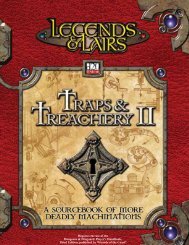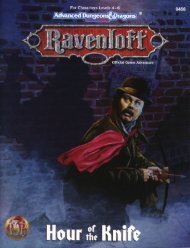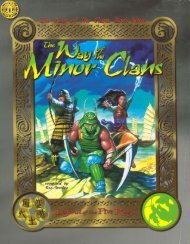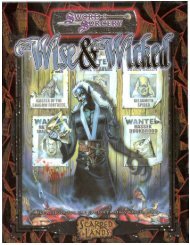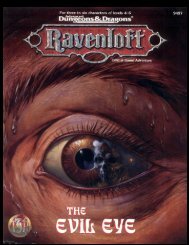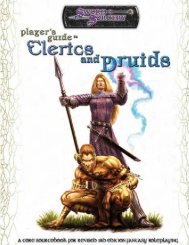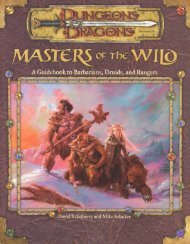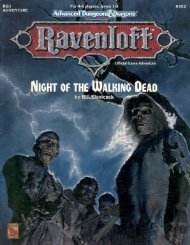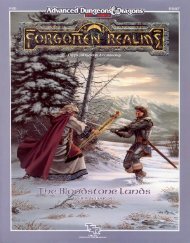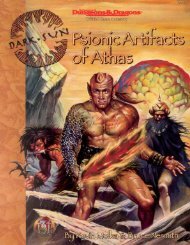Mythic Vistas: SpirosBlaak - Property Is Theft!
Mythic Vistas: SpirosBlaak - Property Is Theft!
Mythic Vistas: SpirosBlaak - Property Is Theft!
You also want an ePaper? Increase the reach of your titles
YUMPU automatically turns print PDFs into web optimized ePapers that Google loves.
This chapter contains a few of the Archduchy’s more notable<br />
organizations. GMs may use them as key elements in their campaign<br />
or merely as background plot elements.<br />
Barbas Fusiliers<br />
First marshaled at Kannis during a summer of protracted wood elf<br />
raids nearly four centuries earlier, the Barbas Fusiliers were formed<br />
from expert marksmen with forest skills matching those of the elven<br />
invaders’, individuals capable of using the elves’ own tricks against<br />
them. Since, the Barbas Fusiliers served as scouts for the citadel,<br />
patrolling the lands for miles and keeping a lookout for raiders,<br />
bandits, and other threats. Several times since their founding, they<br />
marched to war with the legions, serving as spies, scouts, and<br />
skirmishers, but they are most effective when in their native woods.<br />
The Fusiliers limit their membership to natives of the region who<br />
can prove their loyalty, bravery, and knowledge of the local area and<br />
woods; additionally, their members must meet the Fusiliers stringent<br />
marksmanship requirements.<br />
Crimson Company<br />
Members of the Crimson Company wear white robes with crimson<br />
striping and sashes over their armor. With a tradition reaching back<br />
to the reign of the first pontiff, they steadfastly guard the See of Vas,<br />
filling both practical and ceremonial roles. A full platoon always<br />
guards the Pontiff himself, even if not always visible to those in holy<br />
ruler’s presence.<br />
Nobody except the Pontiff and members of the Crimson Company<br />
know how new members are selected or where they are trained.<br />
All company members are without family and have no ties to the<br />
community outside of their glorious position with the See. They are<br />
stalwart bastions of faith who are steadfastly loyal to the Pontiff.<br />
Dark Riders<br />
Formed in Nonum soon aer the kav inflicted horrors upon the village<br />
during the Clan Wars and strengthened aer the Shiblight troubles,<br />
the Dark Riders are a secret society of humans that expanded their<br />
hate to include all races other than their own. Marked by a taoo of<br />
three black, tapering thorns spiraling toward the right on the same<br />
axis, these twisted men and women plot to make the Archduchy safe<br />
for humanity. Not all such plans involve killing, but the Dark Riders<br />
make no secret that genocide is the preferred method of victory.<br />
New members are recruited, and a sponsor brings the candidate<br />
into the organization. The reason for all the secrecy is because<br />
membership is illegal in the Archduchy. The Dark Riders survive<br />
due to their limitless wealth and well-placed contacts that ensure<br />
officials look the other way when needed.<br />
The Ducal Legions<br />
The ducal legions consist of 1,000 common, self-sufficient legionnaires<br />
and their command staff. Each legion is divided into two cohorts of<br />
five maniples each, with each maniple containing two centuries of 10<br />
phalanxes of 10 men each. The legion is designed so every soldier can<br />
carry his own weapons, personal gear, and share of camp equipment,<br />
thereby foregoing the need for a heavy support staff, except on long<br />
campaigns. A junior centurion—who follows the commands of<br />
his century’s centurion, reporting directly to the maniple’s seniorcenturion—leads<br />
each phalanx. Each of the five senior centurions<br />
serves the legion’s commander, the tribune, who are in turn directed<br />
by the region’s prelates and the generals above them.<br />
Specialized legions, such as artillery, cavalry, and musketeers,<br />
typically consist of only 400 men divided into two cohorts of four<br />
maniples (for a total of eight maniples). Cavalry and musketeer<br />
maniples contain five cadres of 10 men each, while siege or artillery<br />
maniples separate into cadres of one to three siege engines or field<br />
pieces, respectively, depending upon their type.<br />
The individual duchies maintain and pay for their own legions,<br />
which fall under their command unless summoned to duty by the<br />
capital, along with fulfilling their usual annual requirement of levies<br />
to the Archduchy’s legions. All legionnaires are well-trained fighters<br />
and they bear the colors of their home upon their sleeves and cloaks<br />
with pride. Most ducal legions split between outlying patrols and<br />
garrison duties. The duchies maintain their legions at the best<br />
possible strength their coffers and populations allow, as no duchy<br />
wants its neighbor to have greater military power than they have.<br />
Each duchy arms its legions slightly differently. For instance, Vas<br />
outfits its fighting men in polished breastplates with longswords,<br />
shortspears, and large metal shields to match, whereas <strong>SpirosBlaak</strong><br />
prefers chainmail, longswords, halberds, and no shields. Variations<br />
are as follows.<br />
Archducal<br />
Volunteers and conscripts fill the individual ducal legions. Each<br />
duchy is responsible for meeting its tithe of trained soldiers,<br />
resulting in units trained in a dozen different ways with a dozen<br />
different (and oen uncomplimentary) weapons. Because of their<br />
motley nature, Archducal legionnaires rarely ever come to work<br />
properly together as a unit before their term of service ends and<br />
the soldiers are returned to their home forces. In truth, they are<br />
effectively lile beer than irregulars. As such, the ducal legions<br />
oen fill their tithes with troublesome men, conscripted for various<br />
criminal infractions. These units get the worst assignments and are<br />
treated badly by the regular ducal forces.<br />
Askalan<br />
Askalan’s infantry legion uses long spears and wears studded<br />
leather armor, allowing them to perform complex maneuvers known<br />
to baffle opponents. The city’s siege legions employ odd mechanisms<br />
capable of tearing down, blasting through, or detonating the<br />
steadiest of fortifications—when they function, that is.<br />
Dreij<br />
Dreij’s infantry legions use longswords, scale mail, and steel shields<br />
for close work. Sure-riding cavalry legions cover their flanks. One<br />
cavalry unit is a light, carbine-wielding unit employing hit-and-fade



